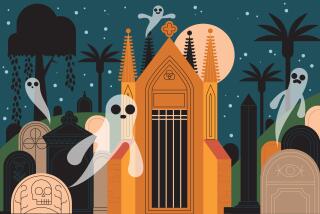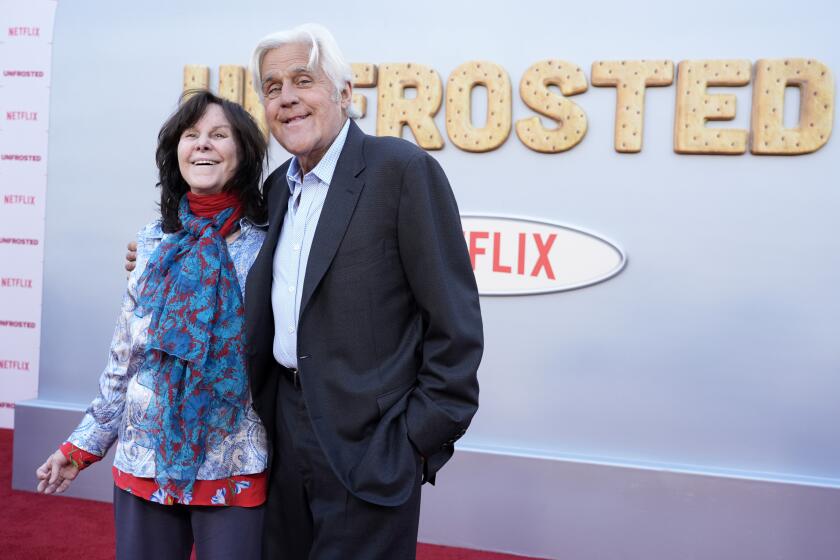NoHo Could Be L.A.’s Unlikely Answer to SoHo
- Share via
David Guthrie wears the lean, hungry, pierced look we expect from young avant-gardians of the ‘90s. There’s the wispy beard, the leather jacket and the left ear that’s been punctured to accommodate a half dozen bits of jewelry. (This may seem extreme, until you think of Van Gogh.) Another sliver of metal pierces Guthrie’s left eyebrow.
“People will come up to me and say, ‘Hey, you’re kind of weird looking,’ ” says Guthrie, 21, sitting with a satchel of drawings inside a North Hollywood coffeehouse. “ ‘Is this an arts district or what?’ ”
New York has SoHo, a fact that has long inspired envy in Los Angeles. So much envy, in fact, that not long ago, some pioneering artists, theater people and sympathetic public officials with millions to spend set out to create a kind of SoHo West, staking out the hardscrabble Downtown terrain east from Spring Street to the concrete banks of the L.A. River. The effort failed.
Today, L.A. offers the humble alternative of NoHo, a little wordplay on North Hollywood, home to L.A.’s latest bohemian phenomenon. Lankershim Boulevard plays the lead and Magnolia Avenue a supporting role in this unlikely urban drama.
Who would have thought that the San Fernando Valley, so long derided as cultural wasteland, might give L.A. a SoHo, sort of, to call its own?
*
Don Eitner isn’t surprised. A former executive with the North Hollywood Chamber of Commerce, he has just returned home after 2 1/2 years in a small Texas city, where he restored a community theater. Eitner, before hooking up with the North Hollywood chamber, was artistic director of a theater company that in 1987 moved over the hill from Hollywood proper to North Hollywood.
“There’s already a community here,” Eitner explains. “That’s the big difference between here and Downtown.”
Eitner, in a recent meeting of the chamber’s NoHo Arts District Development Committee, rehashed some of the troubled relationship between the Community Redevelopment Agency and L.A.’s theater community.
The CRA sunk more than $23 million into the Los Angeles Theater Center, which had been the centerpiece of Spring Street renewal efforts before it went bankrupt in 1991. Theatergoers never felt entirely comfortable with a neighborhood better known for its homeless and drug dealers who had first dibs on the turf. LATC’s failure heralded the collapse of Gorky’s, the arty eatery that had inspired comparisons to SoHo in the first place.
Meanwhile, NoHo, without its nickname, was slowly taking shape, evolving naturally in a part of town that has long served as a suburb for the entertainment industry. Unlike Downtown, which offered artists little more than the virtue of cheap space, North Hollywood offered more for young actors, musicians and dancers looking for the big break. Here is a different kind of arts neighborhood, an L.A. kind of arts neighborhood, inspired more by the ambitions of people who dream of Hollywood success than the rarefied tastes of New York galleries. “The cartoonists union gallery is right here on Lankershim,” Eitner notes.
NoHo boosters love to talk about the proliferation of playhouses, up from eight to 18 in the last couple of years. The Lankershim Arts Center is expected to open next month, the American Renegade Theater is relocating close to NoHo’s heart and Actors Alley, buoyed by $270,000 in aid from the CRA and loans from the Small Business Administration, plans to reopen the historic, quake-damaged El Portal theater toward the end of the year. Unlike the small Equity Waiver theaters that forgo union rates, El Portal, with about 350 seats, will offer the Valley’s first Equity playhouse in 27 years. The last one was sold to a church.
Some old buildings are being saved and some are being torn down. The quake forced American Renegade out of its old quarters on Magnolia, which may be just as well. “That place is haunted,” explains David Cox, artistic director.
The building, it seems, used to house a mortuary. Cox says that mysterious forces turn on the radio, dim the lights and have even pushed him through doorways.
One theory blames the ghost of comic actor Lou Costello. He was embalmed and eulogized there. Perhaps he’s looking for Abbott.
*
“When it catches, it will catch like wildfire, like Melrose and La Brea,” says Brian Sheehan, an actor and proprietor of the Eclectic Cafe. “I’d like to go to sleep and wake up in two years. This place is going to be jammin.’ ”
And in about 2001, Metro Rail is expected to open its NoHo Station--and that is, indeed, the official name. The subway won’t just bring locals, but tourists drawn by MCA’s planned $3-billion transformation of Universal Studios in L.A.’s first “destination resort.”
David Guthrie, the young artist, also figures NoHo can’t miss.
“Then they’ll raise the rents,” he adds, “and kick us out.”
More to Read
The biggest entertainment stories
Get our big stories about Hollywood, film, television, music, arts, culture and more right in your inbox as soon as they publish.
You may occasionally receive promotional content from the Los Angeles Times.










